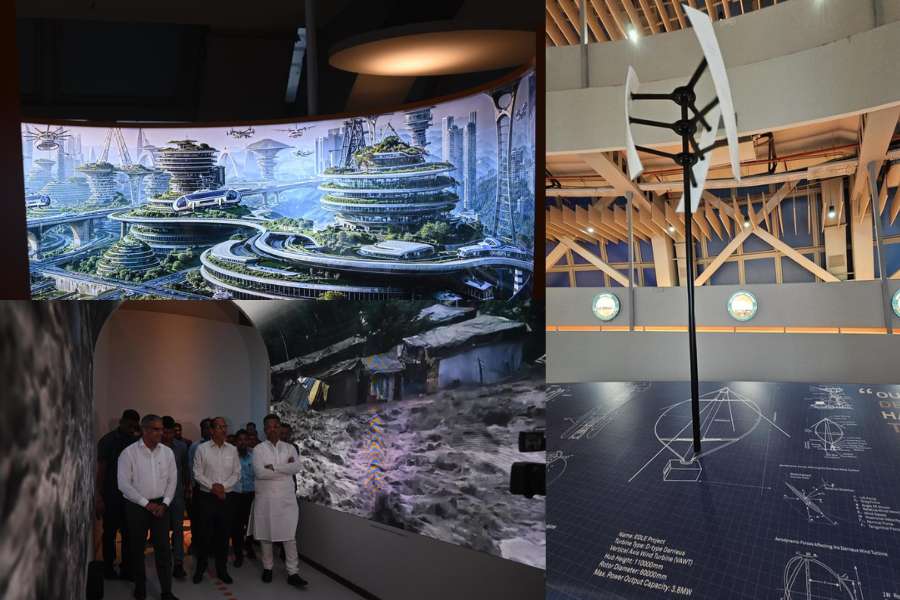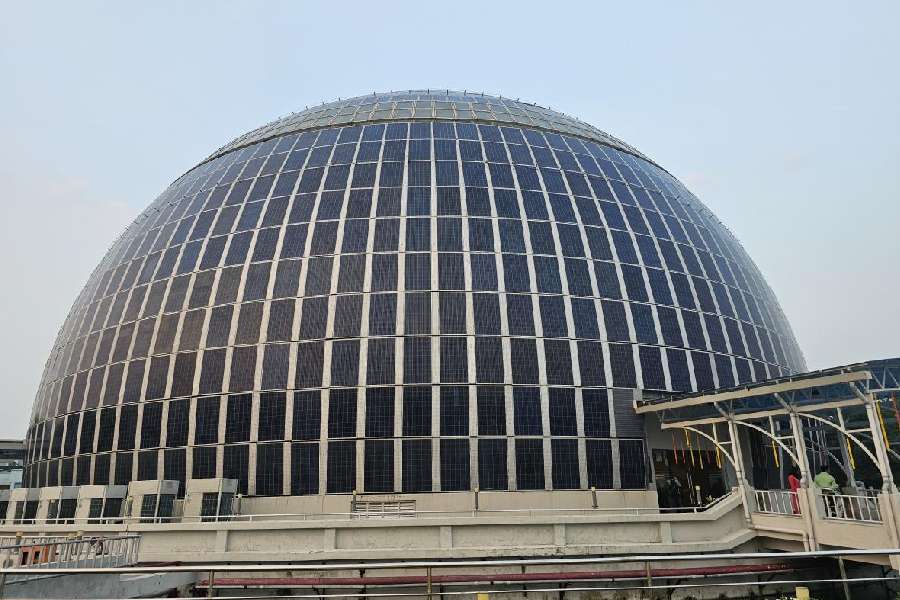India’s first renewable energy museum officially opened its doors on Tuesday. The dome-shaped structure has come up beside the herbal garden, next to Gate 6 of Eco Park.
A joint initiative undertaken by the Housing and Infrastructure Development Corporation (Hidco) and the West Bengal State Electricity Distribution Company Limited (WBSEDCL), the Solar Dome, built on 2.89 acres, stands at a height of 27m and a diameter of 45m and is fitted with 1,986 solar panels that can produce a maximum of 180KW electricity to power the internal lighting of the facility.
“The museum is dedicated to creating awareness about the current climate crisis and how we, as a community and as individuals, can contribute by taking sustainable steps to mitigate this problem,” said Mantosh Roy of the City Centre-based Salient Design Studio, which was the designing consultant for the museum. A three-member team, headed by principal architect and interior designer Vivek Singh Rathore, also comprising Debjeet Bhowmik and Roy, who was in charge of data and research, worked on the project.

A forest city of the future at the top level of the Solar Dome (top left); Minister and Hidco chairman Firhad Hakim being shown around by MD Sanjay Bansal after the opening (top bottom); A vertical axis wind turbine (right) Pictures by Sudeshna Banerjee and Bishwarup Dutta
The foundation of the three-storeyed Solar Dome Museum was laid in February 2017 but the project got delayed by the pandemic. Once the structure was ready, a design contest was held. Salient, which won the contest, started work three years ago.
A smart electric vehicle is on display in the lobby cum atrium space as a vehicle of the future. The visitor is greeted by a humanoid robot which can rotate its neck, move its hands and speak. On sensing human presence, it speaks to welcome the visitor. Next to it stands a shorter robot, almost like the endearing R2-D2 partnering C-3PO in George Lucas’s Star Wars trilogy. While there are two humanoid robots, there are six of the shorter ones, called Curio, with one stationed on each level, said Sanjay Bansal, the managing director of Hidco. They have come from the Ahmedabad-based Vama Communications, the head contractor for the project, which specialises in conceptualising, developing and managing technology-enabled immersive museums and experiential spaces.
“Curio is programmed to brief visitors on the exhibits against a special ticket costing Rs 100 over and above the entry fee. Visitors to a floor will be allowed in groups of 25, monitored by a floor marshal, to ensure exhibits are not mishandled,” said a guide, showing how Curio comes to life on the relevant instruction being chosen on its touchscreen panel and starts following a line across the floor and stops in front of an exhibit to speak about it. “It is fitted with ChatGPT, so it can also answer general questions sourcing responses from the Internet unless the question is provocative,” he said. If left idle, it makes its way back to its resting spot.
The first exhibit it guided The Telegraph Salt Lake to, strolling by a silicon figure of Nikola Tesla seated outside holding an incandescent filament bulb, is on the history of energy, highlighting key inventions like coal usage in 1690, electric generation in 1830, and nuclear fission in 1938.
Beyond this, the thematic levels start. A spiral ramp connects six galleries. The first is dedicated to the climate change crisis itself — how it came about. Interactive kiosks show instances of the effects of the exploitation of Nature over two centuries — oil spill in the ocean, extreme flood in Brazil, rain flood in Dubai, heat wave in India, cyclone in Madagascar, wildfires etc. A wall is dedicated to the climate change timeline while an electronic globe maps the rising temperatures over the years of each region that the user wants to track. Six tunnels have inverted U-shaped LCD screens that show causes of the climate crisis through spectacular sights of glacial melting, wildfires and oil spills.
At the foot of the ramp is a banyan tree under which stands the figure of Saalumarada Thimmakka, a 113-year-old lady from Mysore who has planted and tends to 385 banyan trees along a highway. One walks up by fibre-reinforced plastic models of birds like dodo, spix macao, kamao and passenger pigeon as also animals like trotting harness horse and marsupials like desert rat kangaroo and broad-faced potoroo. “We have chosen 60 species of the 711 lost in the last 200 years,” said Roy.
There are four vision theatres in the museum, two of which are on the next level. Meant to seat a score and more spectators, the theatres screen short films on related topics. “We will change the films from time to time,” said Bansal.
A series of kiosks contain information on the Paris Climate Accord, history and the present-day scenario on renewable energy and the like. After the crisis, there is a sliver of hope in a gallery on types of renewable energy. “We are not doomed yet and we have a chance if we shift to renewable energy,” Roy said.
In the space on hydel power, there is an interactive water pressure game in which two players can compete by pumping a console to fill up a virtual water column in front.
The digital panel shows the energy produced in the process. The geothermal gallery speaks of the heat at the centre of the earth. A panel says: “A mere 0.1% of the earth’s heat content could supply the total energy needs of humanity for 20 lakh years”. “We can reach a hot rock layer by digging just four kilometres, where water turns into steam energy,” the guide explained. The section on wind energy has a model explaining how a wind turbine blade creates energy. “Real-life blades are six times bigger,” smiled the accompanying guide. There were also smaller replicas of horizontal and vertical axis wind turbines. A game has a desert on three sides of which there are knobs to control wind speed, direction and area of wind flow. Correct use of the controls turns the desert area into greenery. A solar smart flower also attracted the eye. “It folds its petals at sunset, protecting the solar panels from adverse weather. It also cleans itself,” said the guide. He also pointed to a dish antenna-like structure overhead. “That’s a solar cooker. It can cook anything placed on it,” he said. Walking up the ramp is made interesting by the mention of the distance covered and the calories burnt. “Of course, it also depends on the speed at which one is walking and one’s body type,” the guide smiled.
The next level is a gaming zone with Albert Einstein himself welcoming visitors. There is a climate quiz, a virtual game on climate change and a smart cycle fixed to the spot. If one starts cycling, a display board shows the distance travelled, time, speed, calories burnt and the wattage generated. There is also a digital assembly game on types of hydro and tidal turbines. The fifth level, with a Steve Jobs figure at the entry, shows a film on Calcutta in 2100 in the vision theatre. It is indeed a space-age scenario with high speed levitating vehicles in the sky, thermo-regulatory jewellery and a circular economy. One can test one’s knowledge by testing oneself in an environment quiz at a console. A smart city model is projected on a panel. The top level, with Elon Musk, has a Tesla Model B e-bicycle replica. The panels show various user-friendly futuristic gear like a Solar Tree or a Shine Turbine, both of which are portable sources of energy for one’s electronic devices in remote places like a desert or a hill top where one might travel. Several screens show panoramic views of futuristic visions like garden city, forest city, floating city and also a city on Mars, which is linked to Musk’s vision of colonising Mars. The sixth floor has a cafe which has a view of the park. “This is because all along the parameter, glass panels have been fitted in between the rows of the solar panels to allow one to see through,” said Roy. The adjacent gift shop sells cute-looking solar lamps and recording devices.











